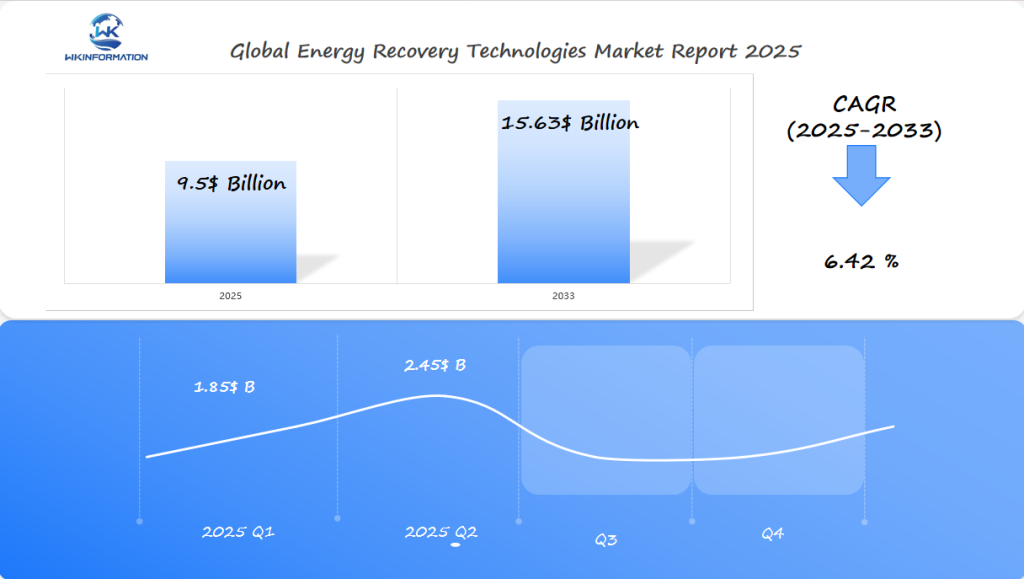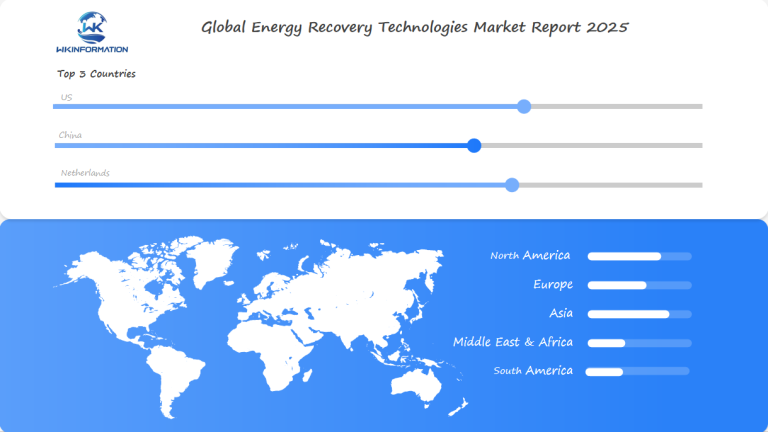Energy Recovery Technologies Market Set to Hit $9.5 Billion Globally by 2025: Sustainability Drive Accelerates Growth in the U.S., China, and the Netherlands
Discover how the Energy Recovery Technologies Market is transforming sustainability with innovative solutions, driving global growth to reach $9.5 billion by 2025.
- Last Updated:
Energy Recovery Technologies Market Performance in Q1 and Q2 of 2025
The global Energy Recovery Technologies market is expected to reach $9.5 billion in 2025, underpinned by a healthy CAGR of 6.42% from 2025 to 2033. The year began with Q1 revenues estimated at $1.85 billion, and Q2 projections indicate growth to $2.45 billion, as industries seek to optimize energy efficiency amidst global sustainability targets. This uneven quarterly growth reflects a strong ramp-up in infrastructure projects and green mandates entering implementation phases.

Key Takeaways
- Energy recovery technologies market projected to reach $9.5 billion by 2025
- Sustainability drives significant market expansion across industries
- Technologies focus on converting industrial waste energy into useful power
- Manufacturing and power generation sectors lead technology adoption
- Innovative solutions support global decarbonization efforts
Energy Recovery Technologies market upstream and downstream industry chain analysis
The energy recovery technologies market is a complex web of players working together for sustainable innovation. An industry chain analysis shows how upstream and downstream parts are connected. This connection shapes the dynamic sector.
Upstream components
Upstream components are the base of energy recovery technologies. They include:
- Raw material suppliers specializing in advanced metals
- Engineering research institutions
- Technology development centers
- Specialized equipment manufacturers
Downstream segments
Downstream segments are also vital in turning technology into real-world use. Key players in this area are:
- Industrial manufacturing facilities
- Power generation companies
- HVAC system integrators
- Renewable energy infrastructure developers
The connections between upstream and downstream parts create a system where new technologies spread fast. Collaborative networks help share knowledge and speed up market changes. This boosts efficiency and sustainability in many industries.
Partnerships between research groups and companies are key for progress. These partnerships help in quick testing and use of new energy recovery solutions.
Decarbonization goals and industrial efficiency are reshaping market momentum
The world is moving fast towards reducing carbon emissions. Energy recovery technologies are key for companies wanting to cut down on carbon and work better. The market is growing fast because of tough green goals and new tech.
What’s driving industrial efficiency include:
- Stringent international climate regulations
- Corporate sustainability commitments
- Increasing economic incentives for green technologies
- Rising awareness of carbon reduction strategies
World leaders and big companies are putting a lot of money into making things greener. Renewable energy integration and better energy recovery systems are now common in making things, power, and moving stuff around.
Investing in energy recovery tech is key to meeting big green goals. By using waste energy, companies can lower their environmental impact and save money.
Barriers include high capital costs and integration complexity
Energy recovery technologies face big challenges in the market. High costs and complex integration are the main hurdles. These issues make it hard for companies and investors to adopt these new solutions.
One big challenge is the cost
Companies need to spend a lot of money upfront to use these systems. The cost can be hundreds of thousands to millions of dollars, depending on the project size and complexity.
- High initial infrastructure investment
- Long-term return on investment timelines
- Technical complexity of system integration
- Specialized engineering requirements
Another challenge is integrating these technologies into existing systems
It’s hard to fit them into current setups without big changes. Many companies find it tough to make these changes without disrupting their operations.
There are new ways to tackle these challenges. Partnerships between public and private sectors, financial help, and step-by-step plans are being used. These strategies aim to make it easier for companies to start using energy recovery technologies.

Geopolitical forces around net-zero pledges and green funding
The global energy recovery technologies market is changing fast. This change is due to complex geopolitical factors. Countries all over the world see sustainable energy as key to their climate plans.
Important factors in the energy recovery world include:
- International net-zero pledges creating regulatory frameworks
- Green funding initiatives supporting technological innovation
- Cross-border technology transfer and collaboration
- Strategic investments in clean energy infrastructure
Rich countries are setting big goals for net-zero. The European Union, United States, and United Kingdom are pushing hard. They use strong policies to get more energy recovery tech used. This helps by offering tax breaks, grants, and good rules for businesses.
New countries are also playing a big role. India and China are using green money to update their factories. Groups like the Green Climate Fund are helping by giving billions for green projects.
The world of energy recovery shows a mix of money, environment, and new tech. Working together and sharing knowledge is key to making the planet greener.
Energy Recovery Technologies market segmentation by type: thermal recovery, pressure recovery, kinetic energy recovery
The energy recovery technologies market is where sustainability meets innovation. It shows how different ways of recovering energy turn waste into valuable resources in many industries.
There are three main types of energy recovery technologies. Each one tackles different energy transformation challenges:
- Thermal recovery systems
- Pressure recovery technologies
- Kinetic energy recovery solutions
Exploring Thermal Recovery Systems
Thermal recovery systems focus on capturing waste heat from industrial processes. They turn lost thermal energy into power, boosting energy efficiency.
Pressure Recovery Technologies
Pressure recovery technologies capture energy from fluid or gas pressure systems. Hydraulic systems and desalination plants are key examples. They turn potential energy into electrical or mechanical power.
Kinetic Energy Recovery Solutions
Kinetic energy recovery solutions capture motion-based energy, mainly in transportation. Automotive regenerative braking systems are a great example. They turn vehicle deceleration into electrical charge.
Energy Recovery Technologies Market Segmentation by Application
The energy recovery technologies market is growing fast. It’s changing how industries work on being more efficient and green. These new solutions are making a big difference in HVAC systems, using waste heat, and making power.
Energy recovery technologies are smart ways to use energy that would otherwise be wasted. By using these systems, companies can cut down on energy use and save money.
Optimizing HVAC Systems
HVAC systems are important for recovering energy. Modern systems can capture up to 80% of the heat from exhaust air, making buildings more energy-efficient.
Benefits of optimizing HVAC systems include:
- Lower heating and cooling costs
- Better indoor air quality
- Reduced carbon emissions
- More consistent temperatures
Industrial Waste Heat Recovery
Manufacturing and chemical plants are using waste heat recovery. They turn waste heat into useful power. This turns excess heat from processes into electricity or mechanical energy.
Power Generation Applications
Power generation is another major area for energy recovery. New systems help generate electricity more efficiently by utilizing thermal energy from power plants and renewable sources.
As we increasingly prioritize sustainability, these technologies will become even more crucial. They contribute to making energy systems both efficient and environmentally friendly.
Global overview of the Energy Recovery Technologies market
The global market for energy recovery technologies is growing fast. It’s driven by worries about the environment and higher energy costs. The market is expected to hit big milestones soon.
Technological advancements and strict rules are pushing growth in many fields.
Regional trends show the market’s wide reach and potential:
- North America leads in technological innovation
- European markets focus on sustainable infrastructure
- Asia-Pacific shows quick industrial adoption
Market size estimates are strong. The global energy recovery technologies sector is set to create a lot of economic value. It’s expected to grow fast.
Companies are putting money into new solutions. These solutions aim to improve energy efficiency and cut down on carbon emissions.
Key factors driving growth include:
- Fast moves towards reducing carbon emissions
- New tech in recovery systems
- More awareness of managing industrial energy
Strategic investments and government support are changing the energy recovery technologies scene. They’re opening up new chances for sustainable growth.

U.S. Energy Recovery Technologies Market: Government Incentives and Smart Grid Upgrades
The U.S. market for energy recovery technologies is changing fast. This is thanks to new government incentives and smart grid upgrades. Federal and state policies are helping to boost energy efficiency tech.
Key Drivers of Market Growth
Key drivers of market growth include:
- Substantial tax credits for renewable energy projects
- Federal grants targeting energy recovery infrastructure
- State-level initiatives promoting clean energy technologies
Smart grid upgrades are changing the energy scene. They make it possible for more advanced energy recovery plans. These upgrades help with:
- Real-time energy consumption monitoring
- Enhanced grid resilience
- Improved integration of renewable energy sources
The Department of Energy is key in backing energy recovery tech. Innovative projects across industrial, commercial, and residential sectors are getting crucial funding. This is speeding up the use of new energy-saving solutions.
Government incentives vary by region, offering special chances for energy recovery tech. States like California and New York are at the forefront. They have policies that push for new tech and green infrastructure.
China's Energy Recovery Technologies Market: Manufacturing Efficiency and Sustainability
China’s energy recovery technologies market is changing fast. It’s driven by big plans for sustainability and making things more efficient. The country’s factories are leading the way in saving energy with new ideas.
Important changes in China show a big push for green manufacturing:
- Aggressive carbon emission reduction targets
- Significant investments in renewable energy infrastructure
- Government-backed technology innovation programs
- Strategic implementation of energy-efficient manufacturing processes
The “Made in China 2025” plan is helping factories become greener. Chinese companies are making top-notch energy-saving tech. This tech meets China’s needs and is also winning in the global market.
Green efforts are making factories more efficient in many areas. Factories are using new systems to catch and use thermal and kinetic energy. This cuts down energy use and costs a lot.
New tech shows China could lead in energy recovery solutions. Market growth is expected to soar in the next few years.
Netherlands Energy Recovery Technologies market: renewable heat and industrial reuse
The Netherlands is a world leader in renewable heat and industrial energy reuse. Dutch innovators are changing the energy scene with new, efficient, and green solutions. These solutions help many sectors work better and more sustainably.
What makes the Netherlands market stand out? Here are the main reasons:
- Advanced district heating networks powered by waste heat
- Innovative industrial energy reuse systems
- Strategic government support for green technology
- Robust infrastructure for renewable heat integration
Data centers and farms play big roles in the Netherlands’ renewable heat plan. They use waste heat from computers and farms to create circular energy ecosystems. This cuts down on carbon emissions and energy use a lot.
The Netherlands has strong rules that help energy recovery tech grow. These rules make it easier for companies to invest in green projects. This makes the Netherlands a key player in renewable energy in Europe.
Industrial areas are quickly taking up energy reuse tech. Factories use systems that catch and use thermal energy from their processes. This not only helps the environment but also saves money on energy costs.
The Netherlands keeps leading in renewable heat and industrial energy reuse tech. It invests in research and development to stay ahead. This sets a high standard for sustainable energy solutions worldwide.
Future direction in AI-assisted energy optimization and compact systems
The world of energy recovery is changing fast. AI and new, small energy systems are leading the way. Artificial intelligence is making energy systems smarter and more efficient.
What’s coming in energy recovery includes:
- Advanced machine learning algorithms for real-time energy efficiency prediction
- Miniaturized compact energy recovery systems designed for diverse applications
- Nanotechnology-enhanced materials improving energy conversion rates
- Smart grid integration with AI-powered predictive maintenance
Research groups are working hard to create intelligent energy optimization platforms. These platforms use smart algorithms to save more energy and reduce waste. They work in homes, businesses, and factories.
New trends show that energy systems will get smaller and more flexible. AI will help manage energy better. This will change how companies think about being green and saving money.
Competitive analysis of key innovators and technology adopters
Key players in the energy recovery technologies market are focusing on developing high-efficiency systems such as regenerative heat exchangers, pressure energy recovery devices, and advanced thermal storage solutions to support sustainability goals across industries. They are expanding into regions like Asia-Pacific and the Middle East, where industrial growth and energy efficiency regulations are accelerating adoption. Strategic collaborations with utility providers and investments in R&D for decarbonization are helping these companies drive innovation and secure a stronger foothold in the global market.
Key Players:
-
CORE Energy Recovery Solutions (Canada)
-
Innergy Tech Inc. (Canada)
-
Ruskin (USA)
-
HOLTOP (China)
-
Greenheck Fan Corporation (USA)
-
Mitsubishi Heavy Industries Ltd (Japan)
-
Waste Management Inc. (USA)
-
A2A SpA (Italy)
-
Veolia Environnement SA (France)
-
Hitachi Zosen Corp (Japan)
Overall
| Report Metric | Details |
|---|---|
| Report Name | Global Energy Recovery Technologies Market Report |
| Base Year | 2024 |
| Segment by Type |
· Thermal Recovery · Pressure Recovery · Kinetic Energy Recovery |
|
Segment by Application |
· HVAC Systems · Industrial Waste Heat · Power Generation |
| Geographies Covered |
· North America (United States, Canada) · Europe (Germany, France, UK, Italy, Russia) · Asia-Pacific (China, Japan, South Korea, Taiwan) · Southeast Asia (India) · Latin America (Mexico, Brazil) |
| Forecast units | USD million in value |
| Report coverage | Revenue and volume forecast, company share, competitive landscape, growth factors and trends |
Global Energy Recovery Technologies Market Report (Can Read by Free sample) – Table of Contents
Chapter 1: Energy Recovery Technologies Market Analysis Overview
- Competitive Forces Analysis (Porter’s Five Forces)
- Strategic Growth Assessment (Ansoff Matrix)
- Industry Value Chain Insights
- Regional Trends and Key Market Drivers
- Energy Recovery Technologies Market Segmentation Overview
Chapter 2: Competitive Landscape
- Global Energy Recovery Technologies Players and Regional Insights
- Key Players and Market Share Analysis
- Sales Trends of Leading Companies
- Year-on-Year Performance Insights
- Competitive Strategies and Market Positioning
- Key Differentiators and Strategic Moves
Chapter 3: Energy Recovery Technologies Market Segmentation Analysis
- Key Data and Visual Insights
- Trends, Growth Rates, and Drivers
- Segment Dynamics and Insights
- Detailed Market Analysis by Segment
Chapter 4: Regional Market Performance
- Consumer Trends by Region
- Historical Data and Growth Forecasts
- Regional Growth Factors
- Economic, Demographic, and Technological Impacts
- Challenges and Opportunities in Key Regions
- Regional Trends and Market Shifts
- Key Cities and High-Demand Areas
Chapter 5: Energy Recovery Technologies Emerging and Untapped Markets
- Growth Potential in Secondary Regions
- Trends, Challenges, and Opportunities
Chapter 6: Product and Application Segmentation
- Product Types and Innovation Trends
- Application-Based Market Insights
Chapter 7: Energy Recovery Technologies Consumer Insights
- Demographics and Buying Behaviors
- TargetAudience Profiles
Chapter 8: Key Findings and Recommendations
- Summary of Energy Recovery Technologies Market Insights
- Actionable Recommendations for Stakeholders

Access the study in MULTIPLEFORMATS
Didn’t find what you’re looking for?
TALK TO OUR ANALYST TEAM
Need something within your budget?
NO WORRIES! WE GOT YOU COVERED!
Call us on: +1-866-739-3133
Email: infor@wkinformation.com
What is the projected market size for Energy Recovery Technologies by 2025?
The Energy Recovery Technologies market is expected to hit $9.5 billion by 2025. This growth is driven by a focus on sustainability and energy efficiency in various sectors.
How do energy recovery technologies contribute to sustainability?
These technologies capture and reuse waste energy from industrial processes. This reduces energy consumption and lowers carbon emissions, making them more sustainable.
What are the main types of energy recovery technologies?
The main types include thermal recovery systems, pressure recovery technologies, and kinetic energy recovery solutions. Each type captures and repurposes energy from different processes.
What challenges do companies face when implementing energy recovery technologies?
Companies face high initial costs, technical complexity, and potential disruptions when integrating these systems. These challenges can affect their operations.
Which industries are most actively adopting energy recovery technologies?
Industries such as manufacturing, power generation, HVAC, chemical processing, and transportation are at the forefront of adoption. Each industry discovers distinct methods to implement energy recovery solutions.
How are artificial intelligence and machine learning impacting energy recovery technologies?
AI and machine learning are making systems more efficient. They optimize energy capture and create smarter energy recovery solutions for various applications.
What role do government policies play in energy recovery technology adoption?
Government policies, such as tax incentives and grants, are key. They help reduce costs and support the adoption of these technologies.
How are different countries approaching energy recovery technologies?
Countries like the United States, China, and the Netherlands have different strategies. They focus on sustainability goals, manufacturing efficiency, and renewable energy programs.
What are the potential future developments in energy recovery technologies?
Future advancements include compact designs, new materials, nanotechnology, and advanced AI. These will make energy recovery more efficient and effective.
How do energy recovery technologies impact overall industrial efficiency?
These technologies greatly improve industrial efficiency. They capture waste energy, reduce consumption, lower costs, and minimize environmental harm.

